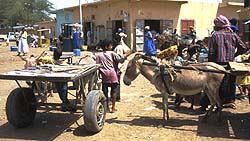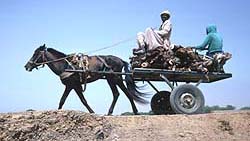|
|
Consider
environmental factors
|
| Adoption
of intermediate means of transport may depend on environmental conditions,
whether social, economic, technological or agroclimatic. Transport
animals, such as donkeys and horses, have clear ecological niches. |
Introducing
donkey transport: successes and failures
Donkeys are adapted to arid conditions: they are mainly found in highlands
or areas with less than 800 mm annual rainfall. Their drought resistance
is a major factor in their increasing popularity. In West Africa,
the southern limit of the donkey population (the ‘donkey line’) has
been moving southwards. As environmental conditions have changed (decreased
rainfall, less bush and lower disease challenge) donkeys have started
to thrive in areas that had previously been unsuitable. There have
been similar expansions of donkeys’ ranges in Eastern and Southern
Africa. |
| The
gradual introduction of donkeys has been due to farmers and traders
purchasing donkeys in existing (drier) breeding areas and bringing
them into the new areas. The overall success of the introductions
(several million donkeys are now used in ‘new’ areas) has been based
on large numbers of small successful attempts—and also very many failures
particularly in the early years. Farmers and traders have arranged
most introductions of donkeys without any government intervention
or support. Some projects
have assisted farmers to obtain donkeys for transport. |

Donkey carts in Guinea Bissau
|
|
Projects that have been successful
have normally been in semi-arid zones, with close target areas.
Major project failures have occurred when projects have attempted
to bring donkeys over large distances and into humid conditions
(eg, Gambia to Sierra Leone, Botswana to Malawi, Zimbabwe to northern
Zambia, northern Uganda to Rwanda).
|
|
Horse pulling cart
in Gambia Horses and donkeys
are susceptible to various health problems and have
distinct ecological niches and management requirements
|
|
 |
|

